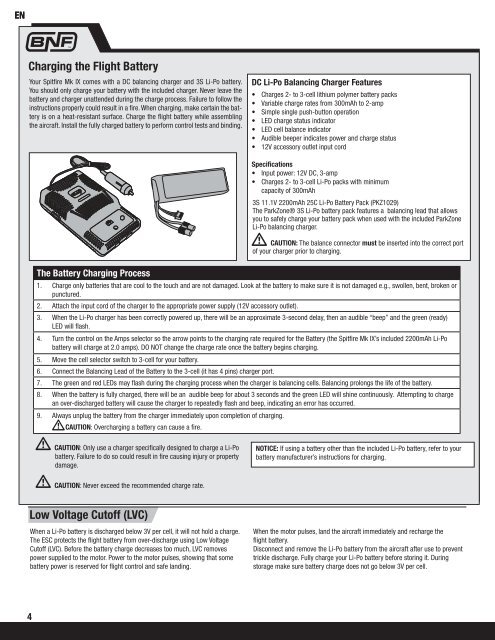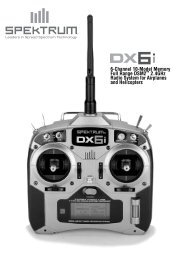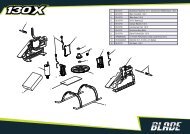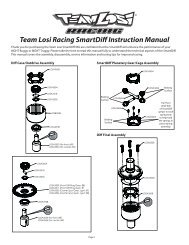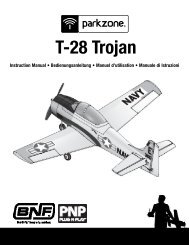30681 Spitfire MK IX Multi Manual.indb - Horizon Hobby UK
30681 Spitfire MK IX Multi Manual.indb - Horizon Hobby UK
30681 Spitfire MK IX Multi Manual.indb - Horizon Hobby UK
- No tags were found...
Create successful ePaper yourself
Turn your PDF publications into a flip-book with our unique Google optimized e-Paper software.
ENCharging the Flight BatteryYour Spitfi re Mk <strong>IX</strong> comes with a DC balancing charger and 3S Li-Po battery.You should only charge your battery with the included charger. Never leave thebattery and charger unattended during the charge process. Failure to follow theinstructions properly could result in a fi re. When charging, make certain the batteryis on a heat-resistant surface. Charge the fl ight battery while assemblingthe aircraft. Install the fully charged battery to perform control tests and binding.DC Li-Po Balancing Charger Features• Charges 2- to 3-cell lithium polymer battery packs• Variable charge rates from 300mAh to 2-amp• Simple single push-button operation• LED charge status indicator• LED cell balance indicator• Audible beeper indicates power and charge status• 12V accessory outlet input cordSpecifications• Input power: 12V DC, 3-amp• Charges 2- to 3-cell Li-Po packs with minimumcapacity of 300mAh3S 11.1V 2200mAh 25C Li-Po Battery Pack (PKZ1029)The ParkZone® 3S Li-Po battery pack features a balancing lead that allowsyou to safely charge your battery pack when used with the included ParkZoneLi-Po balancing charger.CAUTION: The balance connector must be inserted into the correct portof your charger prior to charging.The Battery Charging Process1. Charge only batteries that are cool to the touch and are not damaged. Look at the battery to make sure it is not damaged e.g., swollen, bent, broken orpunctured.2. Attach the input cord of the charger to the appropriate power supply (12V accessory outlet).3. When the Li-Po charger has been correctly powered up, there will be an approximate 3-second delay, then an audible “beep” and the green (ready)LED will fl ash.4. Turn the control on the Amps selector so the arrow points to the charging rate required for the Battery (the Spitfi re Mk <strong>IX</strong>’s included 2200mAh Li-Pobattery will charge at 2.0 amps). DO NOT change the charge rate once the battery begins charging.5. Move the cell selector switch to 3-cell for your battery.6. Connect the Balancing Lead of the Battery to the 3-cell (it has 4 pins) charger port.7. The green and red LEDs may fl ash during the charging process when the charger is balancing cells. Balancing prolongs the life of the battery.8. When the battery is fully charged, there will be an audible beep for about 3 seconds and the green LED will shine continuously. Attempting to chargean over-discharged battery will cause the charger to repeatedly fl ash and beep, indicating an error has occurred.9. Always unplug the battery from the charger immediately upon completion of charging.CAUTION: Overcharging a battery can cause a fi re.CAUTION: Only use a charger specifi cally designed to charge a Li-Pobattery. Failure to do so could result in fi re causing injury or propertydamage.NOTICE: If using a battery other than the included Li-Po battery, refer to yourbattery manufacturer’s instructions for charging.CAUTION: Never exceed the recommended charge rate.Low Voltage Cutoff (LVC)When a Li-Po battery is discharged below 3V per cell, it will not hold a charge.The ESC protects the fl ight battery from over-discharge using Low VoltageCutoff (LVC). Before the battery charge decreases too much, LVC removespower supplied to the motor. Power to the motor pulses, showing that somebattery power is reserved for fl ight control and safe landing.When the motor pulses, land the aircraft immediately and recharge thefl ight battery.Disconnect and remove the Li-Po battery from the aircraft after use to preventtrickle discharge. Fully charge your Li-Po battery before storing it. Duringstorage make sure battery charge does not go below 3V per cell.4


